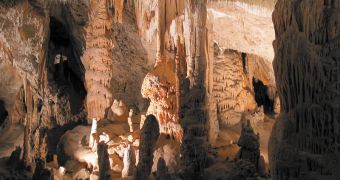Caves represent a world transfixed by millennia, harboring extremely beautiful art works made in limestone by nature's best dab: water.
But not only nature creates valuable art in caves.
Primitive men employed caves against the cold or the hot weather, or to shelter from rains and wild beasts.
On their home caves' walls, the first artistic displays of the man emerged.
They painted the large beasts they wanted to hunt for a better chance.
Many of those animals disappeared but they still look at us on the cave paintings.
In 1879, in Cantabria (northern Spain), at 30 km (18 mi) from Santander, the cave of Altamira was discovered. Inside, there were found a complete skeleton of cave bear and a Ice Age giant deer's bones (this was a deer as big as a bull living on tundras). On the roof of one room paintings depicting wisents, wild horses and wild boars were found. A big shell served to the ancient painter as palette and the materials employed were ochre (haematite) and charcoal.
All were dated 12,000 years old, in the Upper Paleolithic. In 1940 was discovered in France the Lascaux cave system (south-central France). The paintings from Lascaux are 13-25,000 years old and depict wild horses, aurochs (wild cattle), bears, wisents, reindeer and giant deers.
In nearby Montespan cave 20,000 years old paintings of mammoths, horses, wisents, giant deer and hyenas were found.
In one of its gallery clay statuettes of bears and lions were discovered.
In 1959, researchers discovered in the Kapov's cave (southern Urals, Russia) 55 paintings of Ice Age mammals: mammoths, giant deer, steppe horses, bears, lions, woolly rhinoceros. In one room, the researchers even discovered the improvised scaffold employed by the ancient artist.
The colorants employed were red and yellow ochre and charcoal.
In the Bears' Cave (western Romania), discovered in 1975, the skeletons of 140 cave bears trapped 15,000 years ago were found...
In 1818 was discovered in southwestern Slovenia the famous cave of Postojna. It is not famous because of its magnificent 33 m (110 ft) tall rooms, massive columns, its echo and the amazing shapes of stalactites and stalagmites but rather as the home of the only cave amphibian: the famous Proteus, a blind and depigmented salamander, whose only current relatives live in North America and passed through the Ice Ages in the cave system, which maintained a constant 16 degrees C.
In Cuban caves there are also blind cave fishes.
The most famous cave in the US is the Mammoth Cave (central Kentucky), the first in the world as length (591 km or 367 mi), crossed by the Green River. Its illuminated chambers can be visited by car, boat or raft and serve as festivities and theater rooms.
The largest in Europe (and the second in the world) is the 190 km long Holloch cave (Switzerland).
The deepest cave is Gouffre Berger (France) with 1,122 m (0.7 mi) under the ground.
In the mountains of the Majorca Island (Balearic Islands, Spain) there are lakes of salt water and fresh water.
The largest ice cave in the world, 42 km (26 mi) long, is Eisriesenwelt (Austria), 40 km (25 mi) off Salzburg.
40 km off Bogota (Columbia) is located the famous Salt Cathedral, caved for 100 years in the thick old walls of ancient quarries. The gigantic room, whose capacity is of 10,000 persons, could engulf Notre Dame of Paris.

 14 DAY TRIAL //
14 DAY TRIAL // 


